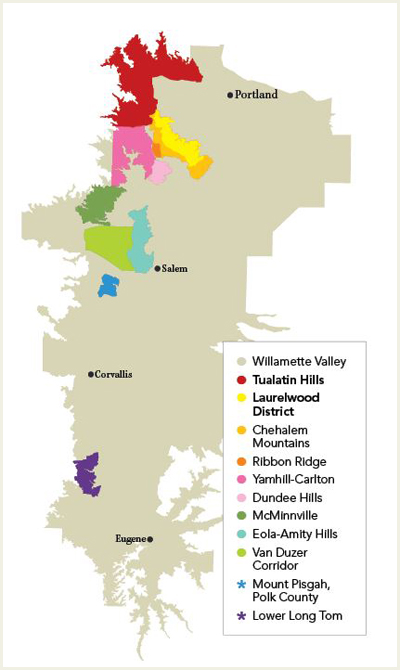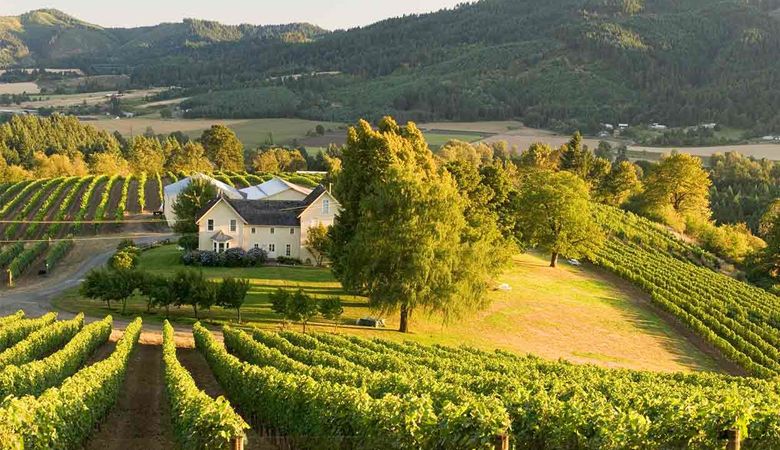New Northern AVAs
Tualatin Hills, Laurelwood District approved
The Willamette Valley keeps adding folds and layers. As of early June, two more sub-appellations were officially outlined on the wine country map with the Tualatin Hills and Laurelwood District AVAs (American Viticultural Areas).
The additions spotlight the Tualatin Valley along the north end of the encompassing Willamette Valley in and around towns like Gaston, Forest Grove, Sherwood and Cornelius. Despite being less than an hour’s drive from Portland, the area is home to some of the oldest vineyards in Oregon, including David Hill, Ponzi, Cooper Mountain and others.
For the record, an AVA is a distinctive area of land possessing unique winegrowing characteristics, like climate, soil type, elevation and geology. The push for regionality reflects what Old World nations like France have done for generations. Just as Pinot Noir shows certain characteristics in Burgundy, it behaves differently in, say, the Yamhill-Carlton AVA. The regional distinctions remain an accessible way to map and market terroir — the ability of a wine to reflect a specific place.
In many ways, the approval of more AVAs validates what those in the industry have suggested since the beginning: The Willamette Valley is full of microclimates, varying aspects and more that have a profound impact on the wines grown there.

At 144,000 acres, the Tualatin Hills AVA essentially follows much of the Tualatin River watershed. Situated in a slightly warmer microclimate, the region resides just north of the Chehalem Mountains and made up of Laurelwood soils. Alfredo Apolloni, owner and vintner at his eponymous label, petitioned for the viticultural area, with substantial help from fellow labels David Hill and Montinore Estate.
The list of 14 Tualatin Hills producers and vineyards also includes Helvetia Winery, Tualatin Estate, Plum Hill Vineyards and Elk Cove Vineyards, to name a few. Rudy Marchesi of Montinore in Forest Grove is pleased to have the Tualatin Hills honored within the greater northern valley scene.
“It requires a lot of documentation and patience, and you have to be factual,” Marchesi said of the petition process. “You have to have a really good argument for people from D.C. who’ve likely never been to Oregon.”
He says the AVA originally included an area that traces all the loess from the Missoula Floods. After discussions with other producers in the Chehalem Mountains, there was a move to settle on the horseshoe-shaped watershed district around the Tualatin River. “The area acted as a catch basin for these soils that were coming in from the west,” Marchesi explained.
Elevations range from 200 to 1,000 feet, with the rain-shadow effect in place. Marchesi offers Pinot Gris as one solid gauge of the singularity of the AVA, which tends to show a citrus and herbal note in normal years, with tropical flavors from warmer growing seasons. “These flavors give Pinot Gris here another dimension,” he explained. The Pinot Noir, on the other hand, differs from the cherry you’re likely to see elsewhere. In the Tualatin Hills, there’s more bright berry notes.
Leading the petition for the Laurelwood District AVA, Luisa Ponzi is second-generation winemaker at the half-century-old Ponzi Vineyards in rural Sherwood. The Ponzi family was aided by the Johnsons of Dion Vineyards in Hillsboro. Less than a quarter of the size of its new neighboring appellation, the Laurelwood District stretches over some 33,600 acres. Lower elevations hold soils like iron-rich loess transported from the cataclysmic Missoula Floods.
The Laurelwood District represents the highest elevation in the Willamette Valley, at over 1,600 feet. The namesake soil is ever-present here, made up of an age-old basalt base topped with windblown silt built up over the last roughly 200,000 years. Fifteen wineries and producers presently call the new AVA home, including Árdíri Vineyards, Freja Cellars, Raptor Ridge Winery and others.
Oregon now boasts 21 AVAs statewide. The Van Duzer Corridor was approved in late 2018. Two more Willamette Valley sub-appellations are pending federal approval: Lower Long Tom in the south near Junction City and Mount Pisgah in the Dallas and Independence vicinity, fairly close to Salem. The U.S. is now home to 248 AVAs and counting, from Arizona’s Sonoita AVA to Kanawha River Valley in West Virginia.











